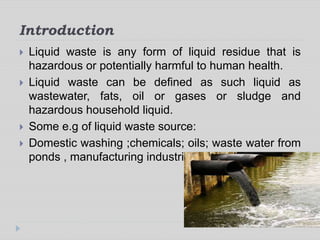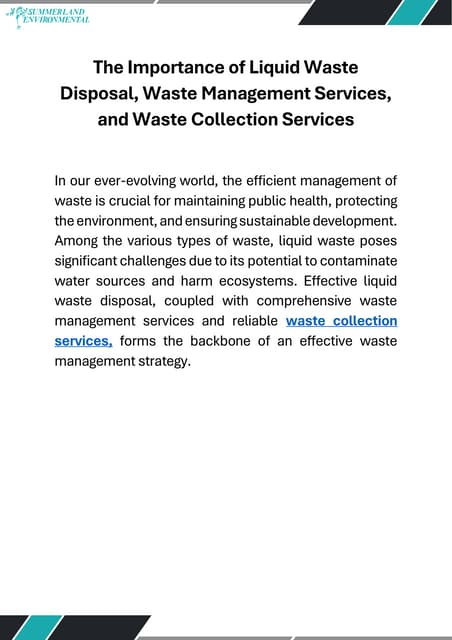Reclaim Waste Things To Know Before You Get This
Table of ContentsReclaim Waste Fundamentals ExplainedThe Best Strategy To Use For Reclaim WasteUnknown Facts About Reclaim WasteThe Ultimate Guide To Reclaim WasteThe Basic Principles Of Reclaim Waste
Domestic sewer waste refers to the waste and items from a residential septic tank. The proper management and disposal of residential sewage waste need liquid waste to be transferred to a sewage treatment plant where the correct approaches and devices are used to purify and dispose of waste.
Business waste usually includes possible threats, such as combustible products or a combination of liquid and strong waste products, and calls for a much more advanced and comprehensive disposal procedure. The disposal of commercial waste normally involves the filtering of waste prior to transportation to ensure risk-free and appropriate disposal. Hazardous waste is developed from results and overflow of industrial processes and production.
This kind of waste can not utilize the same sewer administration transport or procedures as septic or industrial liquids. The hazardous waste monitoring procedure needs the evaluation and testing of liquid waste before it undergoes the disposal procedure (liquid waste disposal melbourne). Drainage waste is the fluid waste that originates from drainage and excess stormwater in highly booming areas or cities
Drainage waste can cause contamination and flooding if not dealt with effectively. Ensuring appropriate waste monitoring can avoid catastrophes and minimize ecological harm.
More About Reclaim Waste
Call PROS Solutions today to find out about our waste administration and disposal solutions and the correct means to look after the fluid waste you produce.
(http://peterjackson.mee.nu/do_you_ever_have_a_dream#c2256)Do you understand what takes place to your water when you disengage, purge the commode or drain pipes the washing maker? No? Well, it's worth knowing. This supposed 'wastewater' is not just a vital source however, after treatment, will be released to our land, waterways or the sea. Made use of water from commodes, showers, baths, cooking area sinks, washings and industrial procedures is called wastewater.

water used to cool machinery or clean plant and equipment). Stormwater, a form of wastewater, is drainage that flows from farming and metropolitan areas such as roof coverings, parks, gardens, roadways, courses and rain gutters right into stormwater drains pipes, after rainfall. Stormwater streams untreated directly to local creeks or rivers, at some point reaching the sea.
Reclaim Waste Can Be Fun For Everyone
In Queensland, most wastewater is treated at sewage treatment plants. Wastewater is transferred from domestic or industrial sites through a system of sewage systems and pump terminals, recognized as sewerage reticulation, to a sewer therapy plant. City governments construct, maintain and run most sewer treatment plants. Operators are accredited under the Environmental Security Act 1994 to release cured wastewater at an appropriate environmental standard right into rivers.
The Department of Natural Resources encourages city governments concerning managing, operating and preserving sewerage systems and therapy plants. In unsewered locations, neighborhood federal governments may need householders to mount specific or family sewage therapy systems to treat domestic wastewater from commodes, kitchen areas, washrooms and laundries. The Division of Natural Resources authorizes making use of house systems when they are verified to be reliable.
In some new neighborhoods, therapy of some stormwater to remove clutter, sand and gravel has actually begun utilizing gross pollutant traps. Wastewater therapy happens in four phases: Gets rid of solid matter.
Wastewater after that moves into large tanks where solids resolve and are gotten rid of as sludge. Oil and scum are skimmed from the surface area. Makes use of tiny living microorganisms recognizes as micro-organisms to damage down and remove continuing to be dissolved wastes and great particles. Micro-organisms and wastes are integrated in the sludge. Gets rid of nitrogen and phosphorus nutrients that could cause algal flowers in our rivers and threaten water life.
A Biased View of Reclaim Waste
Nutrient elimination is not readily available at all sewage treatment plants because it calls for pricey specialized devices. Clear liquid effluent produced after therapy might still include disease-causing micro-organisms - liquid waste disposal.

The majority of wastewater streams right into the sewerage system. Under the Act, neighborhood see page governments carry out approvals and permits for ecologically pertinent tasks (ERAs) including wastewater releases that could have a local influence.
5 Easy Facts About Reclaim Waste Shown
Tracking supplies factual info concerning water high quality and can validate that licence conditions are being satisfied. The info acquired with tracking supplies the basis for making water high quality choices.